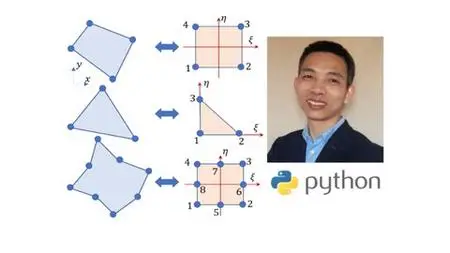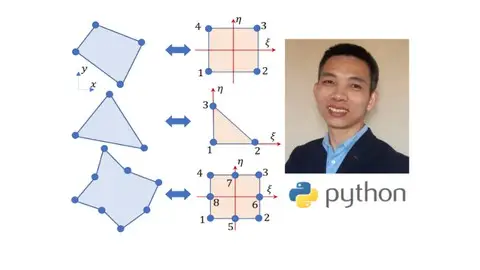Finite Element Analysis with Python - Fundamental-2D
Genre: eLearning | MP4 | Video: h264, 1280x720 | Audio: AAC, 44.1 KHz
Language: English | Size: 4.79 GB | Duration: 7h 32m
Genre: eLearning | MP4 | Video: h264, 1280x720 | Audio: AAC, 44.1 KHz
Language: English | Size: 4.79 GB | Duration: 7h 32m
4-node Quadrilateral Q4, 3-node Triangular T3, 8-node Quadrilateral Q8 Elements
What you'll learn
Fundamental knowledge in FEA specifically for 2D structures
Master in 4-node Quadrilateral (Q4), 3-node Triangular (T3) & 8-node Quadrilateral (Q8) elements
Develop Python codes for FEA for 4-node Q4, 3-node T3, 8-node Q6 elements for 2D structures
The obtained knowledge and skills can be used directly for future practical work and studies
Requirements
Need to have Python already installed in your computer (Python 3 is recommended)
Need basic coding skills in Python (optional)
Description
This course is in an example-based format for 2D Finite Element Analysis using PYTHON. By joining this course, you will learn following main skills
Fundamental theories and formualtions in 2D Finite Element Analysis (FEA).
Mastering theories and formualtions for linear 4-node Quadrilateral element (Q4), linear 3-node Triangular element (T3), and Quadratic 8-node Quadrilateral element (Q8).
Write FEM codes in PYTHON for Q4, T3 & Q8 elements for difenent interesting 2D problems.
A comprehensive study on mesh convergence for Q4, T3 and Q8 elements.
A comprehensive comparison on the performances (accuracy vs computational cost) of Q4, T3 and Q8 elements.
Full 35 slides including theories and formualtions are available to download.
PYTHON FEM codes for all examples are available to download for further study.
All formulations and Python codes are explained.
This fundametal course is part I (basic level in FEM) in my two-level courses for 2D FEA. When you finish this course, you may consider joining another 2D FEA course (part II – intemediate level) where you will learn many more interesting things such as: stress & strain calculations, coupling degree of freedoms in FEA, mesh refinement, multi/composite material structures, etc. By completing these two courses, you will obtain significant knowledge in FEA, especially for 2D structures.
Who this course is for
Engineers and developers who curious about FEA and Structural analysis
Engineering students who want to prepare for a Master or PhD study



